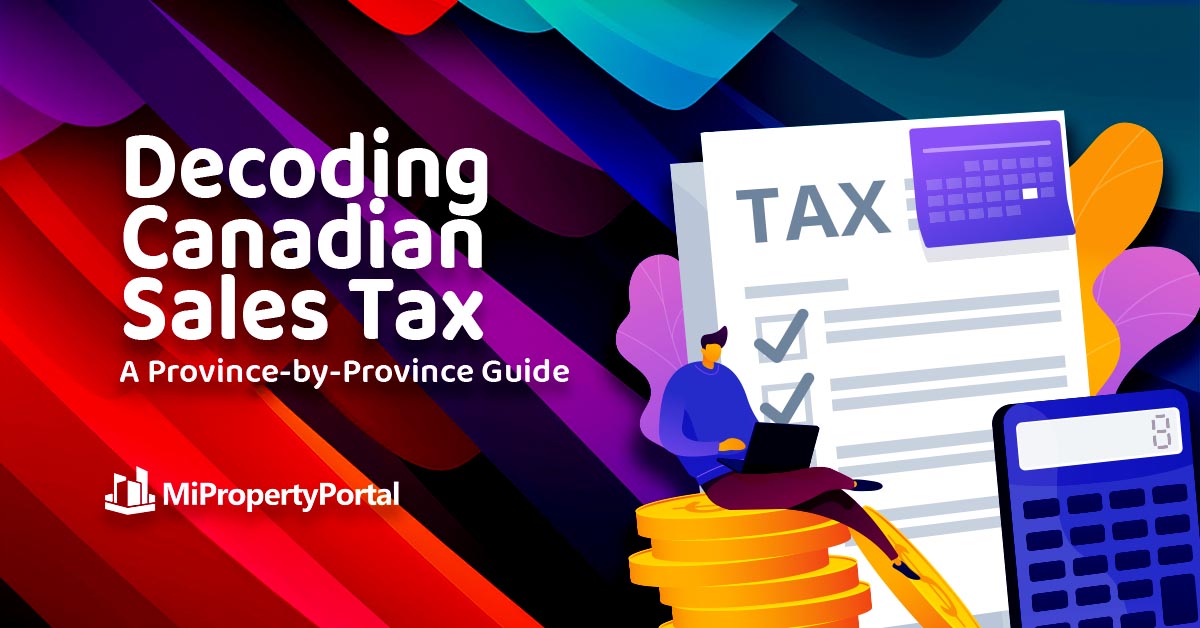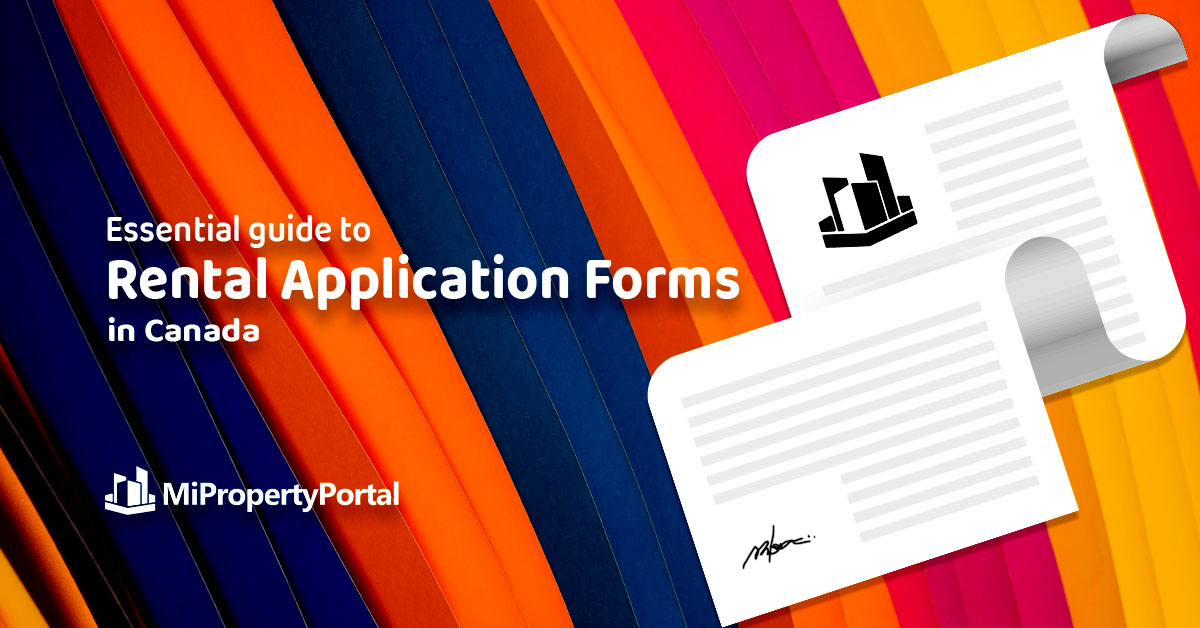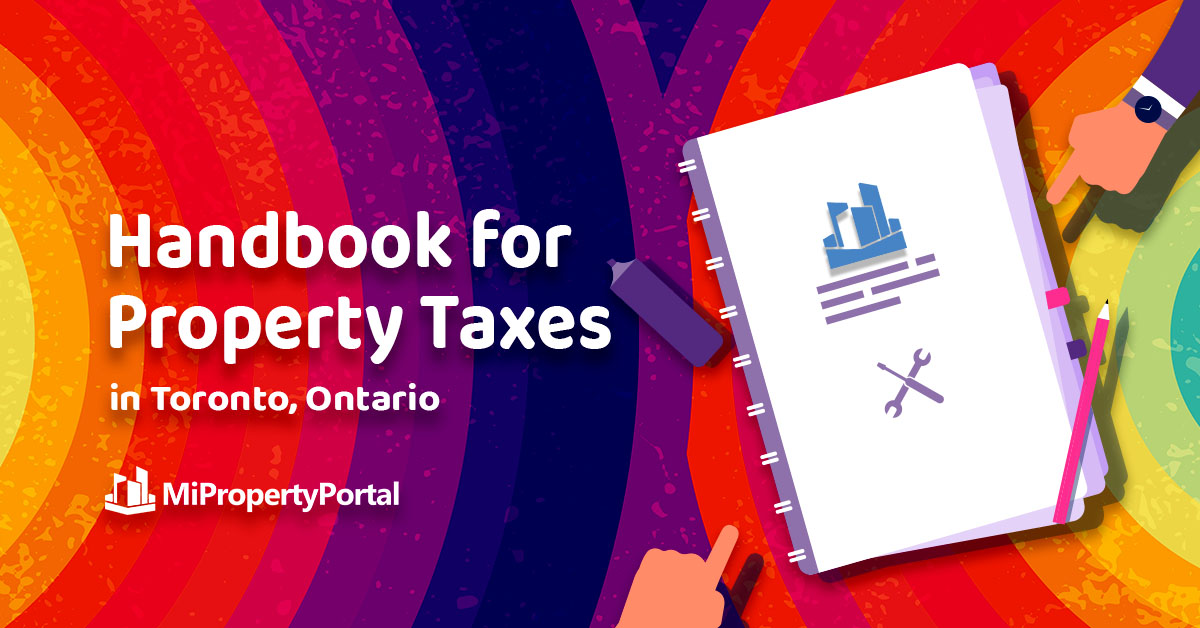In Guide
Decoding Canadian Sales Taxes: A Province-by-Province Guide

Mi Property Portal
December 24, 2023 - 7 min read
The Canadian tax system is progressive, meaning the percentage of tax payable increases as you earn more money. The organization responsible for administering and enforcing tax laws in Canada is the Canada Revenue Agency (CRA).
Each province and territory has its unique tax system to collect taxes from the residents in those regions. In this article, we will talk about the sales tax rates in Ontario, British Columbia (BC), Alberta, Manitoba and Nova Scotia.
What is Sales Tax?
Sales Tax in Canada is a form of indirect tax levied on the sale of goods and services at the retail level. Canada doesn’t have a national sales tax.
The sales taxes in Canada are categorized into three types:
(i) Goods and Services Tax (GST) at the federal level
(ii) Provincial Sales Taxes (PST) or
(iii) Harmonized Sales Tax (HST) in certain provinces.
Here’s a breakdown of the three types of Taxes in Canada:
Goods and Services Tax (GST)
The GST is a federal tax of 5%, applicable to all provinces and territories.
It applies to most goods and services sold in Canada.
Provincial Sales Tax (PST)
Individual provinces levy PST on specific goods and services. Each province has its own rules and rates for PST.
Harmonized Sales Tax (HST)
Certain provinces, like Ontario, Nova Scotia, etc., have adopted the HST.
The HST combines the federal GST with the PST into a single tax rate.
Learn about Rental Income Tax in Canada.
Factors that Determine the Sales Tax Rate in Canada
- Supply Type – Consider the products and services you are offering to determine whether the goods or services are taxable.
- Supply Location – To determine where the supply is made, focus on the customer’s shipping address to charge the appropriate tax.
- Customer Type – The type of customer as some groups of residents are exempted from remitting tax returns.
Registering for a GST account
As per the guidelines of the Canada Revenue Agency (CRA), if your business’s taxable revenue before expenses surpasses $30,000 in the last four quarters, mandatory registration for a GST account is required.
Public service bodies, including non-profit organizations, charities, colleges, and hospitals, must register for a GST account once their taxable revenue before expenses go beyond $50,000.
How to Calculate Sales Tax in Canada?
Businesses operating in Canada need to be aware of the specific rules and rates applicable in the provinces where they operate.
While the Canadian federal goods and services tax (GST) applies to all provinces, some provinces, such as Alberta, the Northwest Territories, etc., have no provincial sales tax (PST).
Some provinces, such as Nova Scotia, Ontario, etc., have the harmonized sales tax (HST), which is a combination of their PST with the GST. They are treated as a single entity, meaning that invoices and bills will have one line for total tax.
However, for business transactions in some provinces such as British Columbia, Manitoba, etc., the GST and PST are considered separate taxes, meaning that invoices and bills will have two separate lines for taxes.
Manitoba refers to its PST as Retail Sales Tax (RST).
Calculate the Sales Tax using an online calculator by the Canada Revenue Agency (CRA) by clicking here.
Ontario Sales Tax
Ontario is a province that charges an HST of 13% on goods and services.
British Columbia (BC) Sales Tax
British Columbia (BC) is a province that charges a separate GST of 5% and PST of 7%, totaling 12% on goods and services.
Alberta Sales Tax
Alberta is a province that only charges a GST of 5% on goods and services.
Manitoba Sales Tax
Manitoba refers to its PST as retail sales tax (RST). Manitoba is a province that charges separate GST of 5% and RST of 8%, totaling 13% on goods and services.
Sales Tax Nova Scotia
Nova Scotia is a province that charges HST of 15% on goods and services.
Quebec Sales Tax (QST)
In Quebec, GST of 5% and QST of 9.975%, totaling to 14.975% are charged on the sale and supply of almost all of goods and services.
Newfoundland and Labrador Sales Tax
Harmonized Sales Tax (HST) of 15% is charged in most sales in the Newfoundland and Labrador province.
Prince Edward Island Sales Tax
In Prince Edward Island, 15% of HST is charged in the Prince Edward Island province.
New Brunswick Sales Tax
In New Brunswick, a HST of 15% is charged. Here, the federal Goods and Services Tax (GST) of 10% and the Provincial Sales Tax (PST) of 5% is combined to 15%.
Saskatchewan Sales Tax
In Saskatchewan, Provincial Sales Tax (PST) of 6% (on Business to Consumer) and a GST of 5% is charged, totaling to 11%. Learn more about the Provincial Sales Tax Act of Saskatchewan.
Overview Of Sales Tax Amounts in Canada (Province And Territory Wise)
The table below gives an overview of Sales Tax amounts in Canada for Ontario, British Columbia, Alberta, Manitoba and Nova Scotia.
| Province | Type of Tax | PST | GST | HST | QST | Tax Rate (Total) |
|---|---|---|---|---|---|---|
| Ontario | HST | 13% | 13% | |||
| British Columbia | GST + PST | 7% | 5% | 12% | ||
| Alberta | GST | 5% | 5% | |||
| Manitoba | GST + PST | 7% | 5% | 12% | ||
| Nova Scotia | HST | 15% | 15% | |||
| Quebec | QST | 5% | 9.98% | 14.98% | ||
| Newfoundland and Labrador | HST | 15% | 15% | |||
| Prince Edward Island | HST | 15% | 15% | |||
| New Brunswick | HST | 15% | 15% | |||
| Saskatchewan | GST + PST | 6% | 5% | 11% |
Legal Considerations for Sales Invoices, Receipts or Contracts for Sales Tax
Receipts and Invoices
Inform your customers about the application of GST/HST to their purchases. You can convey this information through cash register receipts, invoices, contracts, or by displaying signs at your business location. Clearly state whether the GST/HST is included in the price or added separately, along with indicating the applicable GST/HST rate.
Date
The invoice date determines the reporting and remittance (payment) schedule for the GST/HST you have charged. In your return for the period covering the invoice date, include the charged GST/HST, irrespective of whether payment has been received.
Invoice requirements for supplies made to GST/HST registrants
Provide GST/HST registrants with detailed information on invoices, receipts, contracts, or other business documents when supplying taxable goods and services. This information is crucial for providing evidence of their claims for input tax credits (ITCs) or rebates related to the charged GST/HST.
The following table gives information to be included on your receipts, invoices, or other documentation to support claim:
| Information required | Total sale under $30 | Total sale of $30 to $149.99 | Total sale of $150 or more |
|---|---|---|---|
| Supplier's business or trading name, or an intermediary's | Yes | Yes | Yes |
| The invoice date or, if no invoice issued, the date on which the GST/HST is paid or payable | Yes | Yes | Yes |
| The total amount paid or payable | Yes | Yes | Yes |
| An indication of the total amount of GST/HST charged or that the amount paid or payable for each taxable supply (other than zero-rated supplies) includes the GST/HST at the applicable rate | No | Yes | Yes |
| An indication of the status of each supply where the invoice includes both taxable and exempt supplies | No | Yes | Yes |
| The supplier or intermediary's GST/HST registration number | No | Yes | Yes |
| The buyer's name or trading name or the name of the buyer's authorized agent or representative | No | No | Yes |
| A brief description of the property or services | No | No | Yes |
| The terms of payment | No | No | Yes |
GST/HST Return Working Copy
Complete and file your GST/HST return with the GST/HST Return Working Copy. Download the file and fill out properly before GST or HST Return.
Attention all Property Managers and Landlords. Leave the hassle of calculating your Sales Tax with MiPropertyPortal. It automates the filling of GST/HST return working copy so that you can generate the copy with a single click. For a free demo, contact us.
Conclusion
Businesses and individuals need to understand the differences between GST, PST, and HST to ensure compliance and avoid legal issues. Every year, Canadians must file a tax return with the CRA. The tax return reports your income and calculates the amount of tax you owe. Depending on your situation, you may be eligible for various tax credits and deductions.
Learn more about Tax Deductions on Rental Property in Canada.


